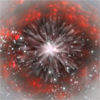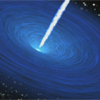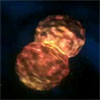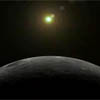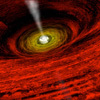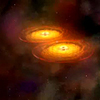CXC Home | Search | Help | Image Use Policy | Latest Images | Privacy | Accessibility | Glossary | Q&A
High-Definition Podcasts are also available. Please see the "Beautiful Universe"
1. Animation of G1.9+0.3
High Definition
This animation begins with a view of the Milky Way from above the plane of the galaxy, where the Galactic center and bulge is unobscured by dust and gas. The viewer then travels towards the center of the Galaxy and zooms into the bright, crowded central bulge of the Milky Way, where a supernova explosion occurs. The ejecta from the explosion rushes outwards where it interacts with the gas surrounding the explosion, causing the formation of a supernova remnant which shines brightly in X-rays and radio waves. This is the scenario scientists envision occurred with G1.9+0.3
[Runtime: 0.23]
(NASA/CXC/A. Hobart)
Related Chandra Images:
High Definition
- Viewable .m4v (14.2 MB)
- QuickTime movie (uncompressed)
- D1 (0.9 pixel aspect ratio)
- 720x486
- 29.97 fps
- file size = (708.8 MB)
This animation begins with a view of the Milky Way from above the plane of the galaxy, where the Galactic center and bulge is unobscured by dust and gas. The viewer then travels towards the center of the Galaxy and zooms into the bright, crowded central bulge of the Milky Way, where a supernova explosion occurs. The ejecta from the explosion rushes outwards where it interacts with the gas surrounding the explosion, causing the formation of a supernova remnant which shines brightly in X-rays and radio waves. This is the scenario scientists envision occurred with G1.9+0.3
[Runtime: 0.23]
(NASA/CXC/A. Hobart)
Related Chandra Images:
- Photo Album: G1.9+0.3
2. Animation of 3C321
High Definition
This animation of 3C321 begins with a close-up of the supermassive black hole in the center of the main galaxy. Hot gas is falling towards the black hole via a blue disk. Some of this material is swallowed by the black hole, but much of it is ejected in a narrow jet of particles traveling at almost the speed of light. The camera then pulls back to show stars and a dust lane in the main galaxy. As the field of view continues to increase in size, the companion galaxy becomes visible as it swings into the path of the jet from the main galaxy. The jet is deflected and disrupted by the impact with the companion galaxy.
[Runtime: 0:46]
(NASA/STScI/G. Bacon)
Related Chandra Images:
High Definition
- Viewable .m4v (27.4 MB)
- QuickTime movie (uncompressed)
- D1 (0.9 pixel aspect ratio)
- 720x486
- 29.97 fps
- file size = (1.3 GB)
This animation of 3C321 begins with a close-up of the supermassive black hole in the center of the main galaxy. Hot gas is falling towards the black hole via a blue disk. Some of this material is swallowed by the black hole, but much of it is ejected in a narrow jet of particles traveling at almost the speed of light. The camera then pulls back to show stars and a dust lane in the main galaxy. As the field of view continues to increase in size, the companion galaxy becomes visible as it swings into the path of the jet from the main galaxy. The jet is deflected and disrupted by the impact with the companion galaxy.
[Runtime: 0:46]
(NASA/STScI/G. Bacon)
Related Chandra Images:
- Photo Album: 3C321
3. Animation of SN 2006gy
High Definition
[Runtime: 0:22]
(NASA/G.Bacon)
Related Chandra Images:
High Definition
- Viewable .m4v (13.2 MB)
[Runtime: 0:22]
(NASA/G.Bacon)
Related Chandra Images:
- Photo Album: SN 2006gy
4. Chandra Spacecraft Beauty Shot
High Definition
This artist's conception begins with the Chandra X-ray Observatory as it passes in front of the Moon. Chandra, one of NASA's "Great Observatories," does not orbit closely around the Earth. Instead, its highly elliptical orbit takes as far as one-third the distance to the Moon. Operating in space since 1999, Chandra detects and images X-ray sources that lie within our Solar System to those billions of light years away. The results from Chandra help explore high-energy phenomena and provide insights into the Universe's structure and evolution. Available in High Def by request.
[Runtime: 0:32]
(NASA/CXC/D. Berry)
High Definition
- Viewable .m4v (13.2 MB)
- QuickTime movie (uncompressed)
- D1 (0.9 pixel aspect ratio)
- 720x486
- 29.97 fps
- file size = (959 MB)
This artist's conception begins with the Chandra X-ray Observatory as it passes in front of the Moon. Chandra, one of NASA's "Great Observatories," does not orbit closely around the Earth. Instead, its highly elliptical orbit takes as far as one-third the distance to the Moon. Operating in space since 1999, Chandra detects and images X-ray sources that lie within our Solar System to those billions of light years away. The results from Chandra help explore high-energy phenomena and provide insights into the Universe's structure and evolution. Available in High Def by request.
[Runtime: 0:32]
(NASA/CXC/D. Berry)
5. Black Hole Animation
High Definition
This animation illustrates the activity surrounding a black hole. While the matter that has passed the black hole's "event horizon" can't be seen, material swirling outside this threshold is accelerated to millions of degrees and radiates in X-rays. At the end of the animation, the black hole is shown shrouded in a cloud of gas and dust, obscuring it from most angles at wavelengths other than the X-rays picked up by the Chandra X-ray Observatory.
[Runtime: 0:27]
View Stills
(NASA/CXC/A.Hobart)
High Definition
- Viewable .m4v (12.5 MB)
- QuickTime movie (uncompressed)
- D1 (0.9 pixel aspect ratio)
- 720x486
- 29.97 fps
- file size = (460.6 MB)
This animation illustrates the activity surrounding a black hole. While the matter that has passed the black hole's "event horizon" can't be seen, material swirling outside this threshold is accelerated to millions of degrees and radiates in X-rays. At the end of the animation, the black hole is shown shrouded in a cloud of gas and dust, obscuring it from most angles at wavelengths other than the X-rays picked up by the Chandra X-ray Observatory.
[Runtime: 0:27]
View Stills
(NASA/CXC/A.Hobart)
6. Chandra Spacecraft Animation
High Definition
In this artist's conception, the Chandra X-ray Observatory is seen in its orbit around the Earth. As one of NASA's "Great Observatories," Chandra can capture X-ray images and measure spectra of X-ray sources from multimillion-degree gases to learn more about black holes and other high-energy cosmic phenomena.
[Runtime: 0:39]
View Stills
(NASA/NGST/CXC/A.Hobart)
High Definition
- Viewable .m4v (14 MB)
- QuickTime movie (uncompressed)
- D1 (0.9 pixel aspect ratio)
- 720x486
- 29.97 fps
- file size = (1.3 GB)
In this artist's conception, the Chandra X-ray Observatory is seen in its orbit around the Earth. As one of NASA's "Great Observatories," Chandra can capture X-ray images and measure spectra of X-ray sources from multimillion-degree gases to learn more about black holes and other high-energy cosmic phenomena.
[Runtime: 0:39]
View Stills
(NASA/NGST/CXC/A.Hobart)
7. Black Hole Merger Animation
High Definition
The movie shows a merger of two galaxies (simulation) that forms a single galaxy with two centrally located supermassive black holes surrounded by disks of hot gas. The black holes orbit each other for hundreds of millions of years before they merge to form a single supermassive black hole that sends out intense gravitational waves.
[Runtime: 0:43]
View Stills
(Animation: NASA/CXC/A.Hobart; Simulation: Josh Barnes (U of Hawaii)/John Hibbard (NRAO))
Related Chandra Images:
High Definition
- Viewable .m4v (12.3 MB)
- QuickTime movie (uncompressed)
- D1 (0.9 pixel aspect ratio)
- 720x486
- 29.97 fps
- file size = (441 MB)
The movie shows a merger of two galaxies (simulation) that forms a single galaxy with two centrally located supermassive black holes surrounded by disks of hot gas. The black holes orbit each other for hundreds of millions of years before they merge to form a single supermassive black hole that sends out intense gravitational waves.
[Runtime: 0:43]
View Stills
(Animation: NASA/CXC/A.Hobart; Simulation: Josh Barnes (U of Hawaii)/John Hibbard (NRAO))
Related Chandra Images:
- Photo Album: NGC 6240


